Store Collette (Belgium)
By the middle of the XIX century, it became clear that the further development of small arms would be associated precisely with the creation of integrated means of storing and feeding ammunition. A direct consequence of this was the emergence of a mass of new original projects that offered some or other ways to enhance the practical capabilities of weapons. For obvious reasons, almost all such projects included the use of new unusual ideas that were tested in practice with ready-made weapons.
In the early fifties of the nineteenth century, Belgian gunsmiths, who worked at the Victor Collett factory (Liege), took up the theme of the magazine weapon. As far as we know, the main contribution to the creation of the new project was made by the owner of the company and designer Erman Jean Nicolas. In 1853, they completed the design, and then applied for a patent. Later, the first samples of promising weapons were made, which were to become exhibition samples. The first public display of the Collette pistol was held at 1855, at the World Exhibition in Paris.
As far as is known, the original design of the shop pistol never received its own name. This weapon in different sources is referred to as the Collette System or the Collette Pistol. In addition, we know the name indicating the principle of operation of the means of ammunition - the Collette Gravity Pistol ("The Collette Gravity Pistol").
The main objective of the new project was the creation of a relatively light and compact weapon, equipped with means of storing and feeding ammunition. To achieve these goals, the project planned to apply several interesting decisions of one kind or another. As a result, the finished gun could look like the existing samples, but it had the most noticeable differences, both in the exterior and in the design.
The new Collette pistol had a general appearance, in general, in keeping with the “fashion” of its time. All units were mounted on a compact metal frame, the upper part of which had a seat for the barrel and the store. A curved handle joined the frame from behind. All means of ammunition were fixed outside the frame; it contained only the details of the firing mechanism.
It should be noted that the Colletta-Nicole pistol was notable for its open location of a number of important details, which to a certain extent limited its resistance to contamination. However, this product was not considered as a weapon for the army. It was planned to bring it to the civilian market and to offer amateur shooters. The use of a pistol exclusively at the equipped shooting ranges made it possible to avoid the mass of problems caused by the open placement of the aggregates.
The frame of the pistol was distinguished by the simplicity of the external contours. It had an increasing cross section, close to rectangular. Its rear part, equipped with fixtures for the handle, differed in increased dimensions. The top of the frame was designed to install the trunk, behind which there were slots for the bolt and the trigger. The trigger bracket was attached to the frame below. For the output of the latter there was a corresponding slot. On the top and bottom, on the back of the frame, there were large curved protrusions, with the help of which it was proposed to join it with the handle.
One of the largest units of the "gravitational" pistol Collette was the barrel. It was made as a large elongation part with an octagonal cross section over most of the length. In the breech section of the breech gradually turned into a rectangular. The barrel had a threaded bore gauge 10,16 mm (0,4 inch) and length 228,6 mm (22,5 caliber).
On the upper part of the trunk was placed the shop of the original design. Its main part was an inverted gutter-cover, mounted on small racks above the barrel. In front of this chute in contact with the upper inflow of the trunk. The latter provided for a round hole with a spring-loaded lid, necessary for the equipment of the store. Behind the cover of the store had a hinge to install the swinging round guide with a folding lock. The guide and lock were connected to the bolt.
A multi-shot pistol was supposed to use special ammunition. V. Collet and E.J. Nicolas chose the .40 caliperless cartridge. This product was a bullet of small elongation, in the back of which there was a relatively large cavity. This volume was intended to load the propelling and igniting charges. When fired, all such a “cartridge” under the action of powder gases left the barrel entirely, without leaving any of its elements in the chamber. This feature of the ammunition greatly simplified the design of the shop pistol.
The original design of the shutter was proposed. The shutter itself was made in the form of a vertically located movable rectangular plate with several protrusions at the top. Its upper part was more thick. The front part of this element had a chamber of the required dimensions, behind which there was a through channel for the striker. On the rear outer surface of the bolt there was a vertical groove for entering the trigger. The lower, more subtle element of the bolt had only a round hole corresponding to the caliber of the barrel. To lock the shutter in the correct position and prevent it from moving to the side, there was a simple system. A small spike was placed on the frame, which entered into a vertical hole in the lower part of the gate. When moving down, the latter was automatically centered.
The upper lugs of the bolt were pivotally connected to the swinging rail of the magazine. Its lower part, in turn, interacted with the corresponding thrusts of the firing mechanism. The first mechanical connection was used in the ammunition system, while the lower one was used when reloading and cocking the weapon.
The trigger mechanism of the Collette pistol was similar to the systems used in single-action revolvers. A swinging trigger of large sizes protruded from the top of the frame. On its front surface there was a firing pin of sufficient length, on the back - a large grip for a finger. Approximately at the level of the trigger axis, under the frame, there was a trigger. Internal parts USM had a connection not only with each other, but also with the shutter. So, when cocking the hammer had to move the bolt, which ensured the preparation of the cartridge to the shot. The trigger got a protective bracket with a protruding rear element.
[Center]
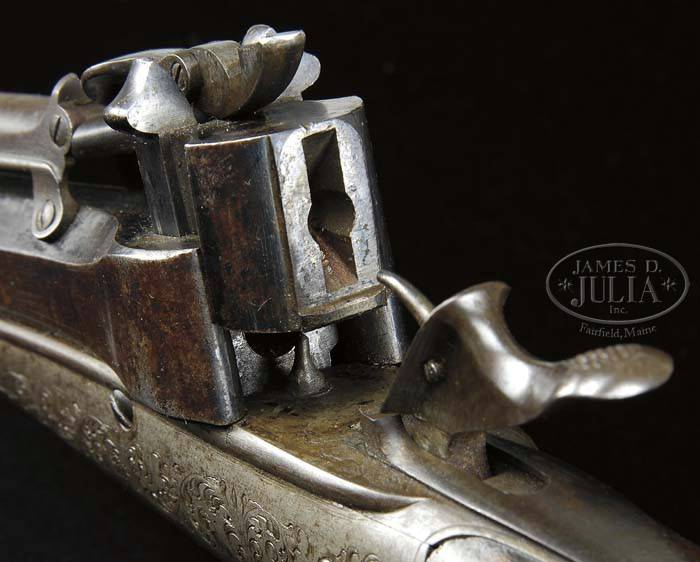
The shutter and trigger. The shutter plate is in an intermediate position. Going up, she will be able to take ammunition. Photo by Jamesdjulia.com
Collette-Nicolas pistol received the simplest sights. In front of the gutter-cover store was a small vertical fly. The back of this cover, next to the hinge of the guide, was bent up and had a rear sight.
The weapon received a wooden handle of complex curved shape, corresponding to the fashion of its time. On the side surfaces of the handle there were longitudinal grooves or notches. Also, wooden parts of the pistols were decorated with carvings. In its ergonomics, the magazine pistol was similar to the single-shot samples of previous models, which had a wide distribution in the first half of the XIX century.
Pistol Collette System had an original principle of operation, some of the features of which were reflected in one of the names. Indeed, in the process of preparing for the shot, gravity played a large role - without it, the cartridge could not get into the chamber, and the new ammunition would not go into the position of filling.
To prepare the pistol for firing, one had to open the front cover of the store and consistently load into it two dozen unusual bullet cartridges. Ammunition was placed in the shop inland: they retained a similar orientation until they hit the target. After loading the cartridges it was possible to close the front cover of the magazine.
The charging process was controlled by moving the trigger. With his lead back half the full stroke, the mechanic raised the bolt up. In this case, the chamber in the upper part of the bolt was in line with the cartridges. At the same time, the bolt lifted the swing guide, which opened the way for the ultimate ammunition. Next, the shooter had to raise the weapon upwards and, if necessary, shake the weapon. Under the influence of gravity, the rear cartridge from the magazine fell into the chamber. Then the arrow should be pulled again to pull the trigger and take it to the extreme rear position. After such a cocking, the trigger was fixed with a sear. The shutter, in turn, under the action of the spring went down, lowering the chamber to the level of the barrel.
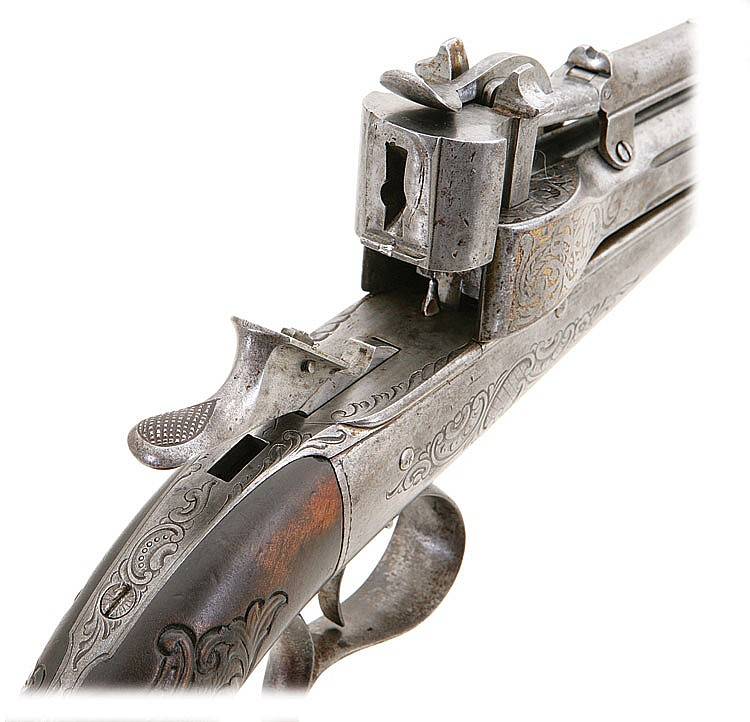
The breech of another sample. Shutter in reload position. Trigger cock lost. Photo Invaluable.com
Pressing the trigger led to unlocking the trigger, which, under the action of the mainspring, went ahead and hit the flammable compound in the cartridge. The igniting and propelling charge created sufficient pressure in the bore and threw a bullet. In this case, the ammunition completely left the weapon, leaving no elements of it in it.
After completing the first shot, the shooter had to pull the trigger again half his turn, turn the weapon upwards and reload. Without the need for equipment store could make two dozen shots.
According to reports, the gun from the company Collette did not differ in high rate of fire, but still could perform several shots per minute, which distinguishes it from a number of other modern systems. The specific cartridge, which was distinguished by its small dimensions and the minimum weight of gunpowder, allowed firing at distances of no more than several tens of meters, and only targets were confidently hit.
The gun was positioned as a weapon for sports or recreational shooting, which to some extent reduced the requirements for it, and also allowed to get the maximum benefit from the existing advantages. As far as is known, these weapons were not offered to the military or the police. It was intended solely for the civilian market.
Soon after the first show at the World Expo, the original weapon went into series. Taking into account the capabilities and wishes of potential buyers, the Collette-Nicolas serial pistols received a very impressive finish. The wooden handle, which had several longitudinal channels for ease of retention, was additionally decorated with carvings, and the steel frame was engraved. Thus, the gun - with all its technical advantages - was able to deliver the arrow also aesthetic pleasure.
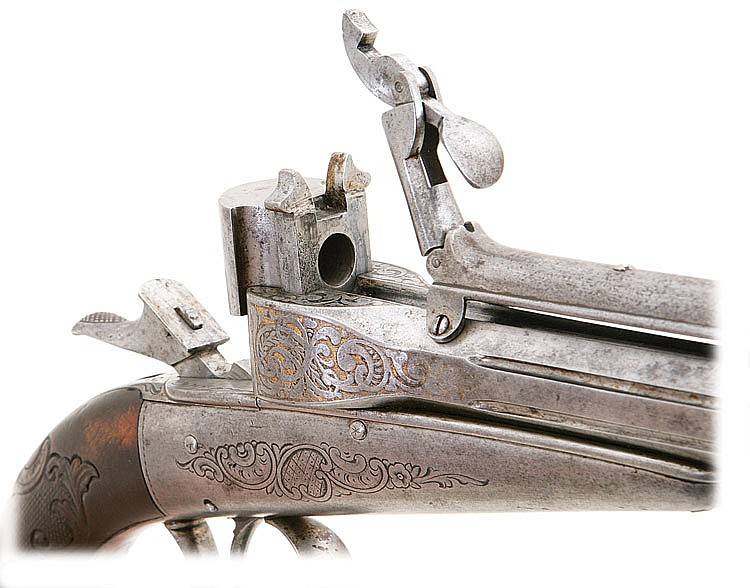
The back of the store is open for maintenance. Photo Invaluable.com
According to various sources, in a few years of production, the Belgian factory managed to produce a relatively small number of magazine pistols. In total, no more than several hundred such products were manufactured and handed over to customers. For obvious reasons, all manufactured pistols were bought by private individuals and used for their intended purpose. The use of such weapons in combat or hunting was simply excluded due to low combat qualities.
Production of Collette pistols lasted for several years and was, on the whole, commercially successful. Despite the relatively high cost associated with the relative complexity of the product and finish, serial pistols were in demand. However, a few years after the pistol was brought to the market, the developer, for several reasons, was forced to curtail its production.
Released pistols remained in the arsenals of amateur shooters and with a certain activity were used by them. Over time, some of these weapons failed or were disposed of as unnecessary. Nevertheless, a number of pistols Colletta-Nicolas lived to this day; now these weapons are exhibits of museums and private collections. From time to time shop pistols appear on various gun auctions. However, due to rarity, this does not happen very often, and the cost of unique samples can reach several thousand dollars or euros.
At the time of the creation of the Collette pistol, optimal and well-developed solutions in the field of weapons ammunition systems simply did not exist. At that time, a lot of new projects of this kind were based on their own ideas, and therefore the main goal of promising designs was to check technical proposals.
V. Collett and E.J. Nicolas offered his own version of multiply-charged weapons and even brought them to mass production. However, the mechanisms they created differed in a number of specific features, which affected the future of the proposed design. "Gravitational" gun from the company Collette remained the only serial model of its kind. With the further development of the shop weapons used other ideas.
On the materials of the sites:
https://forgottenweapons.com/
https://jamesdjulia.com/
http://littlegun.be/
https://invaluable.com/
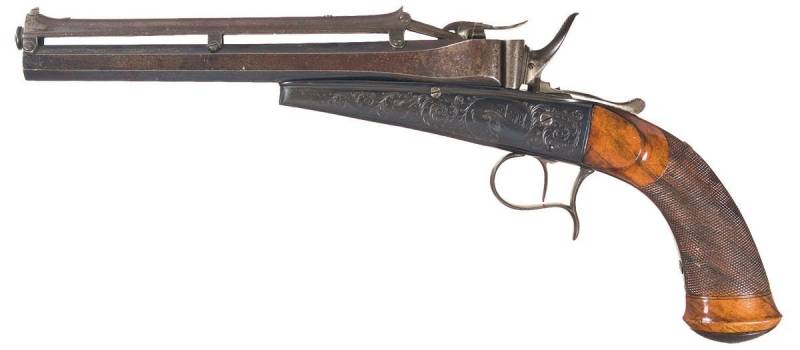
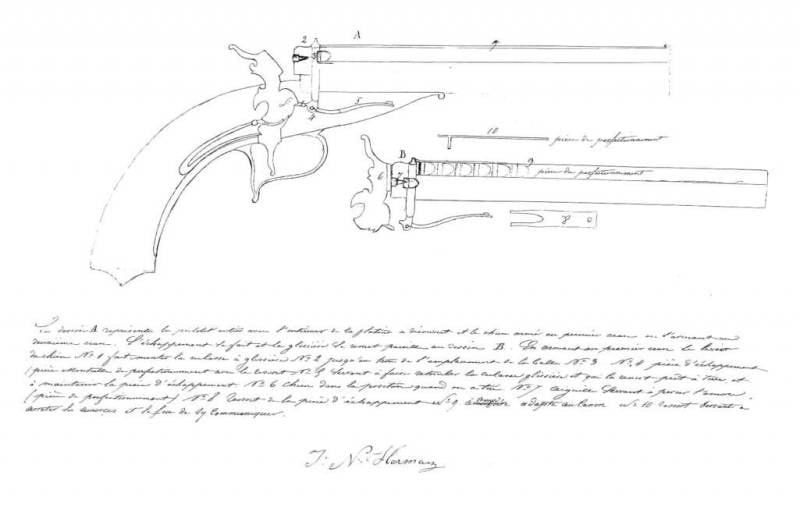
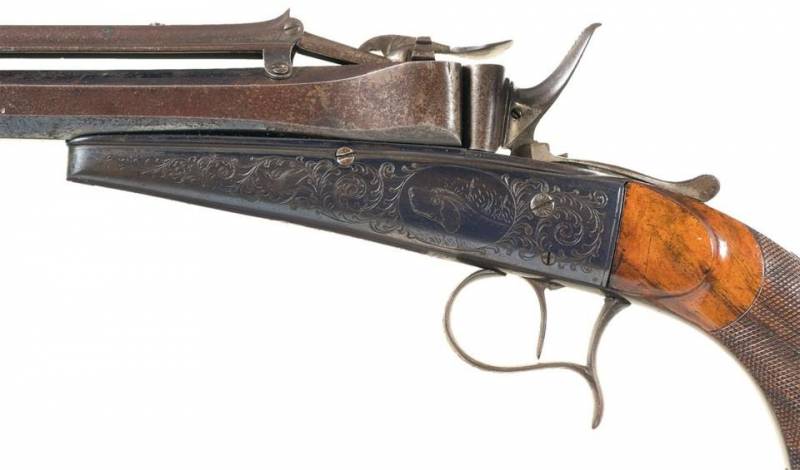
Information